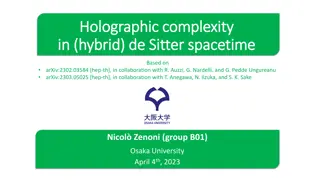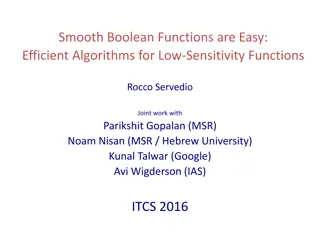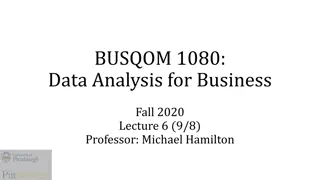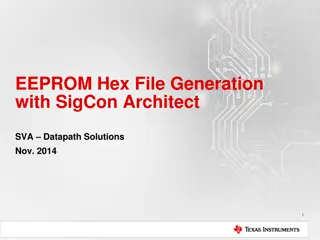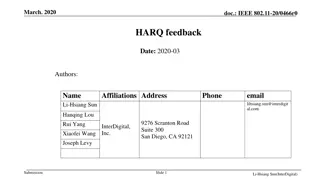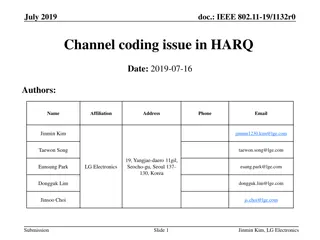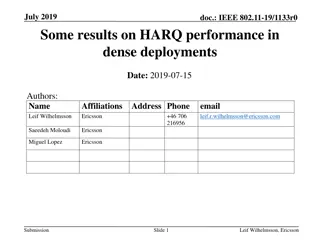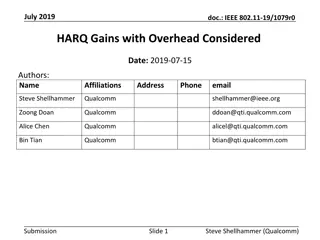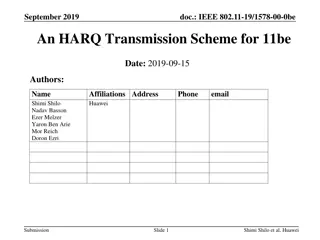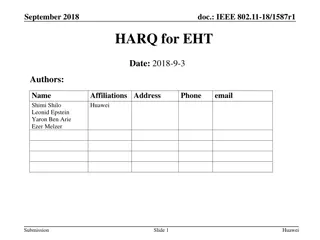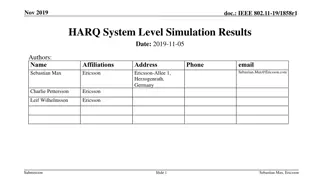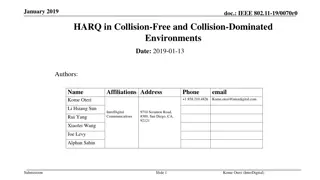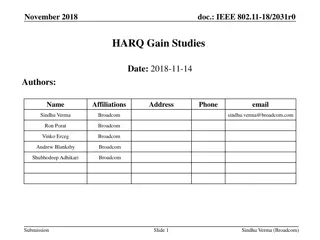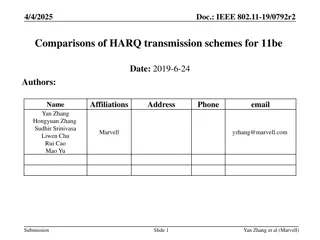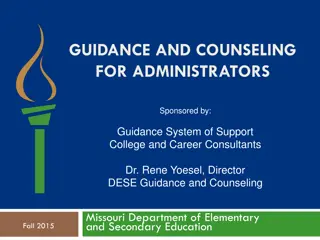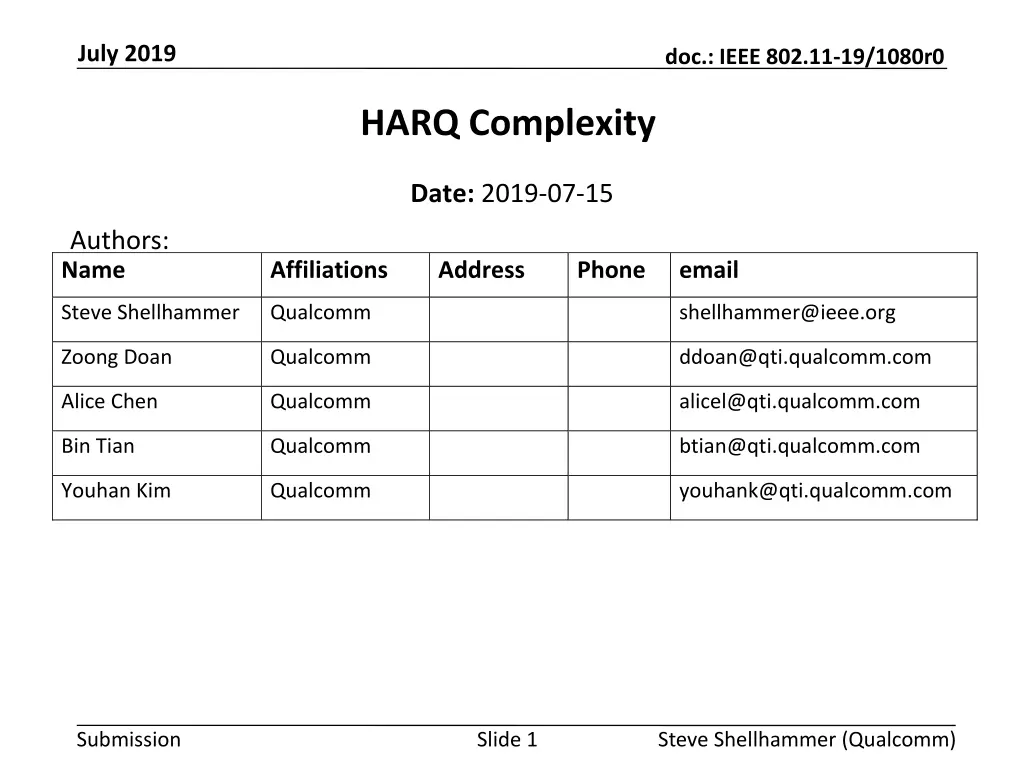
IEEE 802.11-19/1080r0 HARQ Complexity Overview
Explore the complexity and memory requirements of HARQ in IEEE 802.11-19/1080r0, focusing on LLR memory, LDPC codeword processing, and MAC layer operations. Detailed analysis by Qualcomm experts.
Download Presentation

Please find below an Image/Link to download the presentation.
The content on the website is provided AS IS for your information and personal use only. It may not be sold, licensed, or shared on other websites without obtaining consent from the author. If you encounter any issues during the download, it is possible that the publisher has removed the file from their server.
You are allowed to download the files provided on this website for personal or commercial use, subject to the condition that they are used lawfully. All files are the property of their respective owners.
The content on the website is provided AS IS for your information and personal use only. It may not be sold, licensed, or shared on other websites without obtaining consent from the author.
E N D
Presentation Transcript
July 2019 doc.: IEEE 802.11-19/1080r0 HARQ Complexity Date: 2019-07-15 Authors: Name Affiliations Address Phone email Steve Shellhammer Qualcomm shellhammer@ieee.org Zoong Doan Qualcomm ddoan@qti.qualcomm.com Alice Chen Qualcomm alicel@qti.qualcomm.com Bin Tian Qualcomm btian@qti.qualcomm.com Youhan Kim Qualcomm youhank@qti.qualcomm.com Submission Slide 1 Steve Shellhammer (Qualcomm)
July 2019 doc.: IEEE 802.11-19/1080r0 Outline Receiver LLR Memory Requirements LDPC Codeword Processing MAC Layer Processing Submission Slide 2 Steve Shellhammer (Qualcomm)
July 2019 doc.: IEEE 802.11-19/1080r0 Receiver LLR Memory Requirements Submission Slide 3 Steve Shellhammer (Qualcomm)
July 2019 doc.: IEEE 802.11-19/1080r0 Introduction HARQ requires that the receiver save log likelihood ratio (LLR) values for code bits Here we make some first order estimates of the required memory size, in terms of both MB and die area Submission Slide 4 Steve Shellhammer (Qualcomm)
July 2019 doc.: IEEE 802.11-19/1080r0 Basic Assumptions Terminology o We use the term HARQ Sequence to indicate the initial HARQ transmission and any subsequent HARQ retransmissions, for a block of data (e.g. PSDU) Assumptions o A HARQ Sequence completes within a TXOP o In this analysis, we assume there is only a single HARQ Sequence active at a time o Memory is assumed to buffer LLRs for all codewords Greater than 10% probability that all codewords are in error on the first transmission (See backup) Selective codewords buffer is possible with degraded performance. That is not considered in this first order estimate o We will allocate memory for LLRs for all code bits in the codeword. This is required for Chase Combining Incremental redundancy may require comparable or larger memory requirements, depending on the design. Here we will focus on Chase Combining. o We will allocate 5 bits for an LLR Submission Slide 5 Steve Shellhammer (Qualcomm)
July 2019 doc.: IEEE 802.11-19/1080r0 Rough Estimate of LLR Memory Size The Required memory size in MB is given by 106 10242? = 0.715 ? ? 6 5 5 (???? ??? ???) 8 (???? ??? ????) ?????? ???? = ? Where ? is the data rate in Gb/s and ? is the Data Field duration in ms. Here we assume a code rate of 5/6 and 5 bits per LLR. Data Rate (Gb/s) Duration of Data Field (ms) LLR Memory Size (MB) 1 1 0.7 5 1 3.6 10 1 7.2 1 5 3.6 5 5 17.9 10 5 35.8 These rough estimates are for a single active HARQ Sequence Submission Slide 6 Steve Shellhammer (Qualcomm)
July 2019 doc.: IEEE 802.11-19/1080r0 Downlink Examples Required Memory at STA Here we use MCS11 and Two Spatial Streams, and use Chase Combining Here we assume 320 MHz has the same spectral efficiency as 80 and 160 MHz Bandwidth (MHz) Data Rate (Gb/s) Duration of Data Field (ms) Memory Size (MB) SRAM Area (28 nm) (???) 80 1.2 1 0.86 1.17 160 2.4 1 1.73 2.24 320 4.8 1 3.46 4.39 80 1.2 5 4.3 5.43 160 2.4 5 8.6 10.76 320 4.8 5 17.2 21.42 Memory die size for 28 nm and is based on ?.??? ???/?? [1] for memory cells plus 0.1 ???for addressing circuitry Submission Slide 7 Steve Shellhammer (Qualcomm)
July 2019 doc.: IEEE 802.11-19/1080r0 Memory Size (MB) versus Data Field Duration (ms) These examples are for a Single HARQ Sequence The memory requirements grow quickly with increased data rate and increased Data Field duration A short Data Field duration incurs large overhead for HARQ Feedback Submission Slide 8 Steve Shellhammer (Qualcomm)
July 2019 doc.: IEEE 802.11-19/1080r0 LDPC Codeword Processing Submission Slide 9 Steve Shellhammer (Qualcomm)
July 2019 doc.: IEEE 802.11-19/1080r0 Introduction HARQ Transmissions HARQ Transmissions may consist of a subset of the LDPC code bits Examples Punctured Chase Combining (PCC) o Initial Transmission: 100% of the code bits o Retransmission: 33% or 50% of the code bits Incremental Redundancy (IR) Example 1 o Initial Transmission: 80% of the code bits o Retransmission: 20% of the code bits Incremental Redundancy (IR) Example 2, from [2] o Successive Effective Code Rates: 5/6, 3/4, 2/3, 1/2 o Code Bits sent in each TX: 1166, 130, 162, 486 o Smallest fraction of Code Bits in a given TX ?% These are just examples, other designs are possible Submission Slide 10 Steve Shellhammer (Qualcomm)
July 2019 doc.: IEEE 802.11-19/1080r0 LDPC Codeword Transmission Duration T In HARQ it often requires less time to transmit the code bits from an LDPC codeword Hence more codewords are transmitted in a give period of time To keep up with the incoming LCPC codewords, the codeword processing rate must increase For example, if only 20% of the code bits are sent in an IR retransmission the receiver must combine the LLRs from the initial transmission and the retransmission and then decode the LDPC codeword in 20% of the time. o This requires a 5x increase in LDPC codeword processing rate If only 7% of the code bits are transmitted in a given HARQ transmission (as in Example 2) , then the increase in LDPC codeword processing rate is around 15x 100% of the Code Bits from an LDPC Codeword 0.8 T 80% of the Code Bits from an LDPC Codeword 0.2 T 20% of the Code Bits Submission Slide 11 Steve Shellhammer (Qualcomm)
July 2019 doc.: IEEE 802.11-19/1080r0 STA LDPC Decoding Capability Each STA has a maximum LDPC codeword processing rate Increasing that decoding rate would increase implementation complexity The HARQ Transmitter (H-TX) should take into account the LDPC codeword processing rate of the HARQ Receiver (H-RX) Some of the PCC and IR gains come from transmitting a smaller subset of code bits in the retransmission We need to evaluate those gains assuming realistic codeword processing rate of the HARQ receiver Submission Slide 12 Steve Shellhammer (Qualcomm)
July 2019 doc.: IEEE 802.11-19/1080r0 MAC Layer Processing Submission Slide 13 Steve Shellhammer (Qualcomm)
July 2019 doc.: IEEE 802.11-19/1080r0 MAC Layer Processing Not Decoded from Initial HARQ Transmission A-MPDU Decoded from HARQ Retransmission The receiver MAC will need to process part of the A-MPDU based on the initial HARQ Transmission The MAC may not be able to decode some of the MPDU delimiters so parsing the A-MPDU from the initial transmission could be challenging Undecoded LDPC codeword data may not align with MPDU boundaries The receiver MAC will need to process the initial undecoded parts of the A-MPDU based on the HARQ retransmission o This may require storage of parts of the A-MPDU decoded from the initial HARQ Transmission Slide 14 Submission Steve Shellhammer (Qualcomm)
July 2019 doc.: IEEE 802.11-19/1080r0 MAC Layer Processing Example TX#1: 25% CWs fail, e.g., CW2, CW6 and CW11 fail MPDU 1 MPDU 2 MPDU 3 CW1 CW2 CW3 CW3 CW5 CW6 CW7 CW8 CW9 CW10 CW11 CW12 OFDM SYM 8 OFDM SYM 7 OFDM SYM 6 OFDM SYM 4 OFDM SYM 3 OFDM SYM 2 OFDM SYM 5 OFDM SYM 1 TX#2: In Re-Tx, if transmitting 20% of code bits processing needs to be 20x faster MAC MPDU 1 MPDU 2 MPDU 3 C W 2 C W 6 C W 11 OFDM SYM 1 Submission Slide 15 Steve Shellhammer (Qualcomm)
July 2019 doc.: IEEE 802.11-19/1080r0 References 1. Mahmut E. Sinangil, et. al., A 28 nm 2 Mbit 6 T SRAM With Highly Configurable Low-Voltage Write-Ability Assist Implementation and Capacitor-Based Sense-Amplifier Input Offset Compensation, IEEE Journal of Solid-State Circuits, Vol. 51, No. 2, February 2016 2. Yan Zhang, et. al., Comparisons of HARQ transmission schemes for 11be, IEEE 802.11-19/792r1, May 2019 Submission Slide 16 Steve Shellhammer (Qualcomm)
July 2019 doc.: IEEE 802.11-19/1080r0 Backup Submission Slide 17 Steve Shellhammer (Qualcomm)
July 2019 doc.: IEEE 802.11-19/1080r0 Distribution on the Codeword Failure Rate Probability of all codewords failing NSS=2, NTx=2, NRx=2, D-NLOS, BW=20MHz, LDPC(Payload=20000bytes); MCS6: SNR=27dB; PER=0.2645 Histogram (Total of 2645 packet errors out of 10000 packets) 450 400 Empirical CDF 1 350 0.9 Median = 0.28 Mean = 0.42 0.8 300 0.7 0.6 250 F(x) 0.5 200 0.4 0.3 150 0.2 0.1 100 0 0 0.1 0.2 0.3 0.4 0.5 0.6 0.7 0.8 0.9 1 Ratio of Failed CWs 50 0 0 0.1 0.2 0.3 0.4 0.5 0.6 0.7 0.8 0.9 1 Ratio of Failed CWs over All CWs in Packet Conditioned on Packet Failed CW (Codeword) error distribution for MCS6 at Packet error rate around 30% Submission Slide 18 Steve Shellhammer (Qualcomm)



